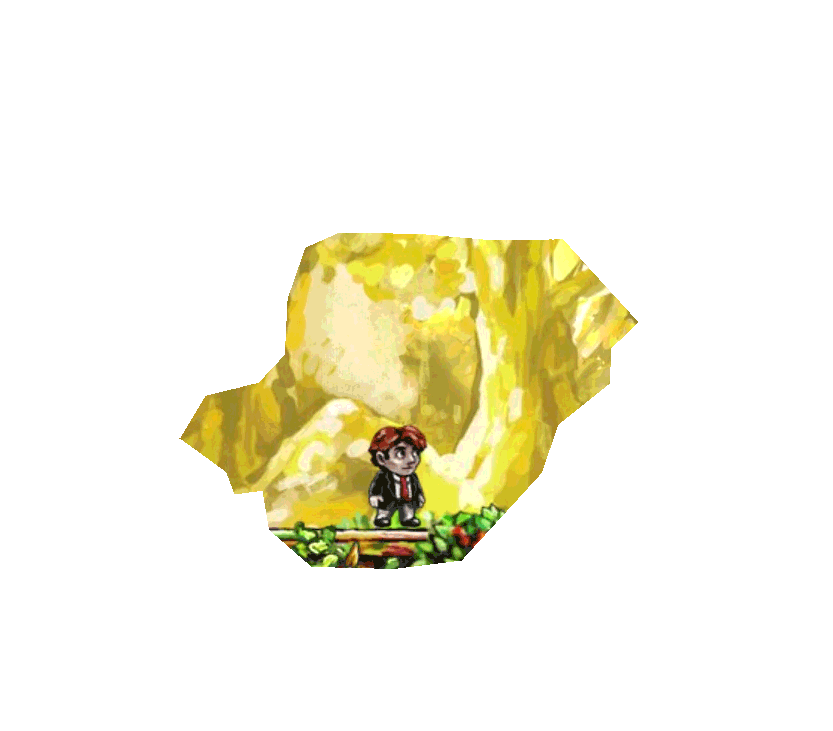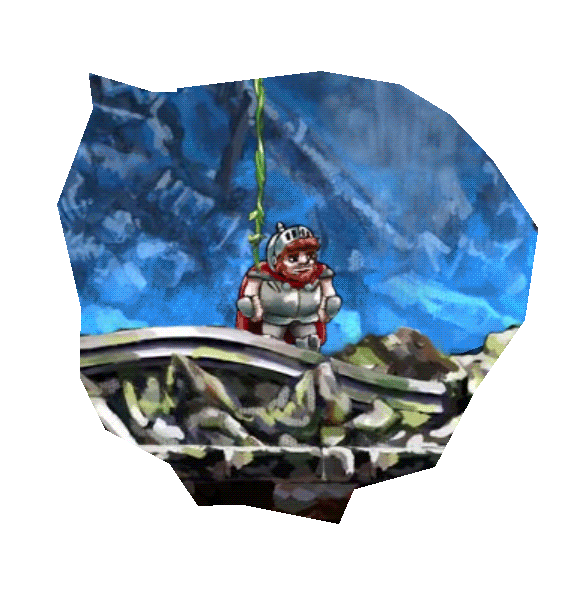


The Narrative Review Competition
-
The Narrative Review Competition takes place every year at the Game Developers Conference. Participants write a paper about the narrative of a game of choice, and winners get a free pass for the conference. Winners also make a poster that summarizes their paper, which they get to present at GDC. My paper on Braid's narrative won one of the three Platinum prices in 2015, and gave me the chance to present my poster for two days at the conference.
Paper sent to the competition in 2015, with updated information.
BRAID'S CHARACTERS

Tim
-
Although Tim is the main character, the player knows very little about him or his circumstances. Tim’s appearance clashes with the environments that surround him. Tim’s attire is both elegant and realistic, while the environments seem to be part of a fantasy universe with goomba-like creatures. Even his hair, of a strange bright red, seems to be out of place. To add to this contrasting effect, Tim keeps a smile of satisfaction and contemplation throughout the whole game, even when he is facing dangerous enemies and challenging puzzles.


Copyright © 2008 by Jonathan Blow


Copyright © 2008 by Jonathan Blow
The Princess

-
As it happens with Tim, players know very little about the Princess, and only at the end do they see her for the first time. Through the game’s story, players learns that Tim and the Princess had some kind of relationship, and that Tim made a mistake at some point. Although the goal of the game is to rescue her from an “evil monster”, players quickly learn that Tim might have never met her before.

The Monster
-
As with the princess, players learn about the evil Monster at the beginning of the game, but they only get to see him at the end. Surprisingly, the monster does not look evil at all. Not only that, but he strongly resembles Tim. This is not a random fact, and fits the game’s conclusion, that implies a strong link between the monster and the main character.


Copyright © 2008 by Jonathan Blow
BRAID'S NARRATIVE

The art
-
Starting with the art, Braid’s fantasy-like environments, play a big role in its narrative. Tim starts the game in an unknown city, where the player can only access one realistic-looking building. After entering a room, Tim finds himself in a fantasy world, where strange bodiless creatures walk around, clouds are platforms that he can step on, and ornamented cannons shoot fireballs at him.

The outside part of the building has a more realistic look and art style
Copyright © 2008 by Jonathan Blow
-
Tim’s appearance fits the building's outside, but feels out of place inside the building’s rooms. This is because the rooms are not part of reality; they are a representation of Tim’s memories. Every time players travel from “reality” (the building) to a fictitious world (one of the rooms), they are accessing Tim’s mind. Tim’s memories present a distorted version of his life, which explains why the worlds are filled with fantasy and impossible creatures.

Entering a room in Braid teleports players to a completely different universe.
Copyright © 2008 by Jonathan Blow
-
Inside the building, each door that leads to a world has a painting above it, which relates to the story told in that world. The puzzle pieces that players need to collect to see these paintings are a metaphor in themselves: the story of the game is a puzzle that players needs to solve. The paintings are not key to understanding the story, but they support it and shed light into some of the key elements of Tim’s personality.

The inside of the building looks like a portal between two worlds, and mixes dream-like environments real world structures.
Copyright © 2008 by Jonathan Blow

The books
-
Not all of Braid’s narrative elements are as subtle as the art, and the game has other more straightforward methods to convey the story. When players enter a new world, they find themselves in a room with several books. Players can read the content of these books, which explicitly explain part of Tim’s story through text. However, the books usually contain vague metaphors and references that are not clear at first glance, forcing players to connect the dots and to figure out the connection between the books’ events and the game’s storyline.

The books give cryptic hints about Tim's past. It is up to players to interpret them.
Copyright © 2008 by Jonathan Blow

The gameplay
-
One of Braid’s differentiating elements is the perfect fit between game mechanics and storytelling. In Braid, the game mechanics are the ultimate way of expressing Tim’s feelings and desires. Tim’s time-related powers are directly connected to the game’s events, and they are key to both solving the game’s puzzles and understanding Braid’s story.

Tim's time-manipulation powers represent his desire to undo his past mistakes.
Copyright © 2008 by Jonathan Blow
BRAID'S WORLDS
-
Each of the game’s worlds sheds some light on Tim’s backstory, his relationship with the princess, and the reasons behind his desire to rescue her. The paintings beside the levels' doors, for instance, reveal events of Tim's past, while the powers that Tim acquires in each level relate to his deepest desires and aspirations. All os these elements are reinforced by the introductory books, which tell Tim's story in an enigmatic way.

Tim's powers serve the narrative, and not the other way around.
Copyright © 2008 by Jonathan Blow

2 - Time and Forgiveness
-
"Time and Forgiveness" tells the story of how Tim made a mistake that destroyed his relationship with the Princess, and how that led to a journey to save the Princess from an "evil monster". In World 2, Tim gets the power to travel back in time and change the past, which is a representation of Tim's desire to undo his past mistakes. This world’s painting shows a woman making a small mistake, which leads to undesired consequences when she spills a bottle of wine.

The painting in World 2
Copyright © 2008 by Jonathan Blow
3 - Time and Mystery


The painting in World 3
Copyright © 2008 by Jonathan Blow
-
“Time and Mystery” tells the story of Tim’s time-related powers, which he obtained in the previous world, and their effect on his relationship with the princess. The books explain that Tim’s ability to go back in time have led to a perfect relationship with the Princess, by allowing him to undo any of his mistakes. However, all his actions are driven by the desire to please her, and now he wants to scape the Princess' influence. In World 3, Tim encounters objects that represent the state of his relationship: they are not affected by time. This world’s painting show Tim’s way of evading reality.

4 - Time and Place
-
In "Time and Place", Tim remembers his childhood, and gets lost in memories. Tim's power in this world is a physical representation of nostalgia: when Tim walks, a lullaby plays and his memories come to life, and when he stops moving, the music and the world stop. One of the books in this world hides an important message for the player. The book mentions that Tim is getting coser to the Princess, "if she exists". This quote questioning the Princess' existence indicates that the princess might not be someone, but something. The princess, after all, might just be a metaphorical representation of Tim’s aspirations.

The painting shows Tim's old room.
Copyright © 2008 by Jonathan Blow
5 - Time and Decision


The painting in World 3
Copyright © 2008 by Jonathan Blow
-
"Time and Decision" reveals that Tim decided to leave the Princess at some point in their relationship. The surprise comes, however, from the last words that Tim says before leaving her: “I have to go save the Princess". Are there two Princesses? Is one of them a person, while the other one is a goal that Tim wants to accomplish? Maybe Tim neglected one of them for the sake of the other. World 5 gives Tim the power to create clones that repeat his actions. While his clones repeat his past mistakes, he can take the right path and avoid getting hurt.

6 - Hesitance
-
Tim has become obsessed with the Princess, and it has affected his life. Whether the princess is metaphorical or not, Tim feels as if he has married her: she is always in his mind. Her constant presence is a big burden on Tim’s life, and it has started to affect his relationship with the people around him. A wedding ring serves as a metaphor for Tim’s obsession with the Princess: the ring is always with him, just like her. Being around the ring has a negative effect on Tim and his surroundings, making the environment feel heavier, and making everything, including time, move slower.

The painting in World 2
Copyright © 2008 by Jonathan Blow
- 1


The painting in World 3
Copyright © 2008 by Jonathan Blow
-
Tim finally meets the Princess and his captor. Surprisingly, the monster looks just like him. Although at first glance, it seems like the princess is asking for Tim’s help, it is soon clear that she is running away from him. Tim is not the savior that the player saw throughout the game, but a monster instead. The game ends with an unsettling reference to the atomic bomb and Tim’s past as a scientist. Is that what Tim was looking for? After all, the Princess and the monster might have just been a metaphor for Tim’s search of a monstrous mechanism.
BRAID'S LESSONS

Time and Storytelling
-
There is not a right way to tell a story. Telling a story from beginning to end is just one possible approach, but there are many other ways. A game can tell a story from end to beginning, it can skip parts, or it can only reveal fragments of it.

Let players wonder
-
As with some books and movies, it is not mandatory to explain the story in detail and explicitly, and it is all right to leave some (or most) details of the story to interpretation.

Don't let text and dialog convey everything
-
Dialog and text are not the only way to tell a story. Developers can use many other resources to communicate with the player, such as art, music, or gameplay. These mechanisms encourage players to think, and force them to pay attention to detail in order to understand the game.

Narrative doesn't need to be secondary
-
Gameplay can be there to serve the narrative, and not necessarily the other way around. The usual game structure, of gameplay with a complementary story that explains it, is not the only one. A game can revolve around a story, and the gameplay can emerge from the events that take place in the game.

Use the game's mechanics wisely
-
Simple mechanics can lead to very complex puzzles. It does not matter if the game’s mechanics are present in other games, but rather if the game uses them in a way that is innovative and surprising to the player. Going back in time is nothing new to the game’s industry, but Braid’s puzzles make players feel like they have never seen anything similar before.

Even in the very last level, Braid keeps its enigmatic aura, giving players the chance to think and reach their own conclusions.
Copyright © 2008 by Jonathan Blow




